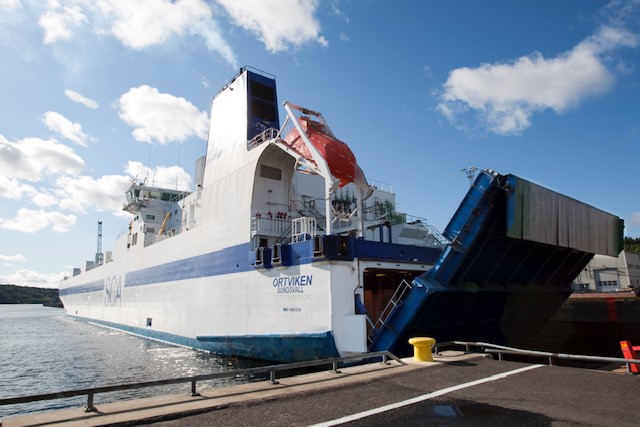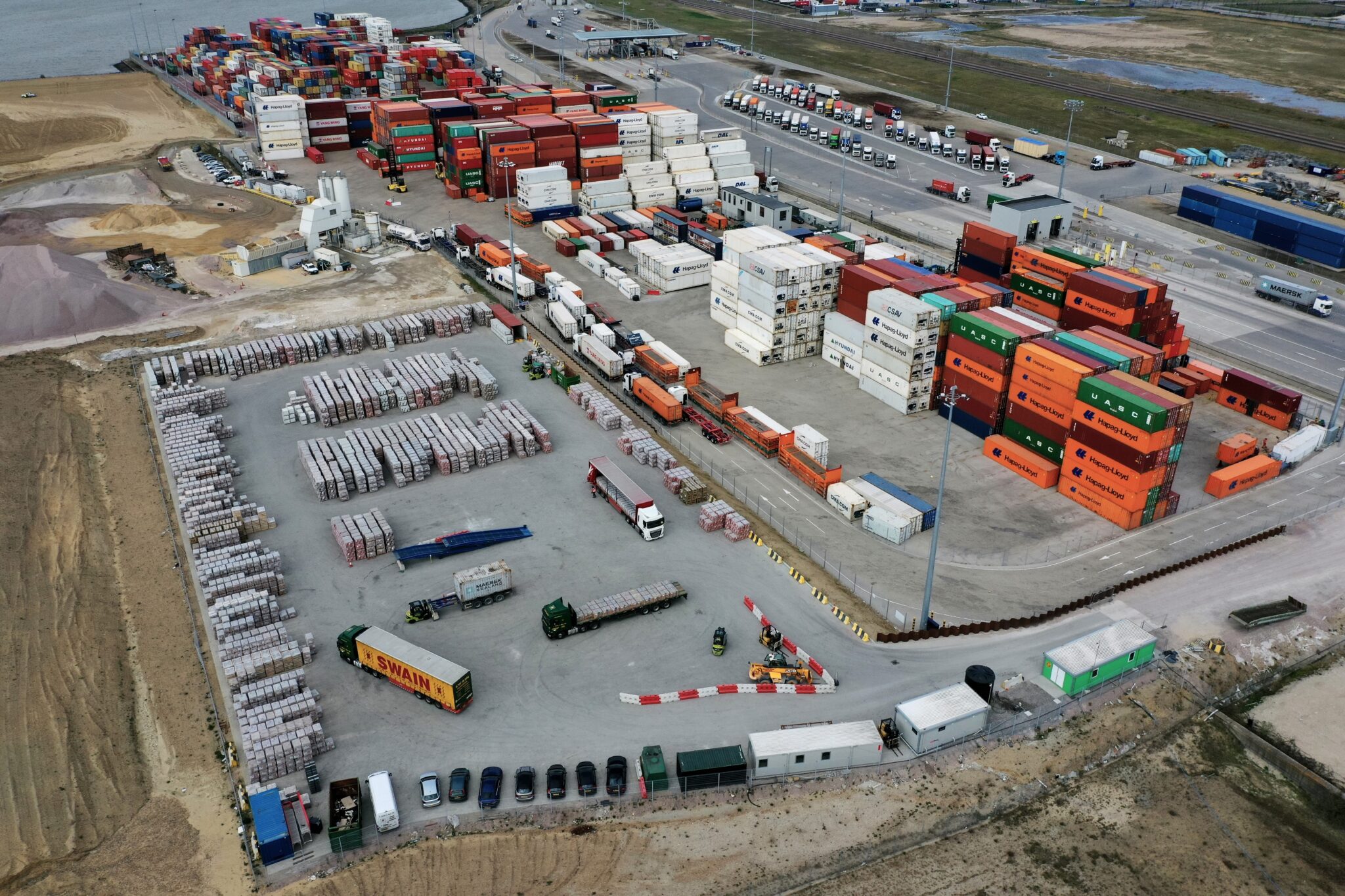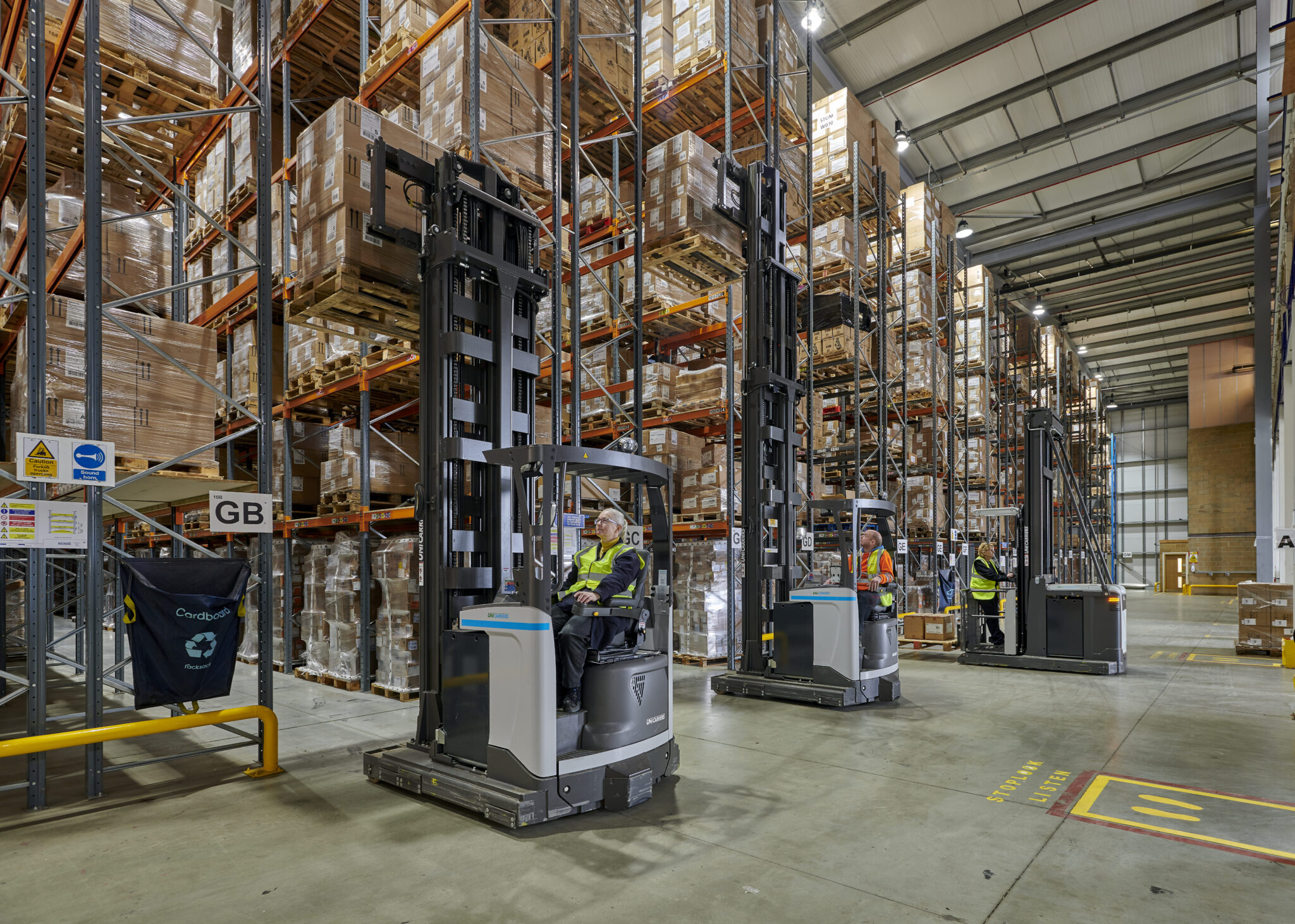UniCarriers has delivered a state-of-the-art e-commerce storage concept comprising a long-term equipment strategy and an efficient material handling operation in a new very narrow aisle (VNA) warehouse for logistics provider Delamode.
An enormous boom in e-commerce over the past few years has led to the need for a new warehouse concept for Delamode PLC’s UK warehouse: The freight and logistics management provider’s double-deep storage system had become inefficient, and the ongoing short-term hire of industrial trucks was no longer up to date.
Delamode began looking for a suitable provider to restructure its warehouse in Braintree, Essex. Longstanding partner UniCarriers offered a VNA warehouse solution with matching material handling equipment. The global manufacturer of industrial trucks delivered not only a seamless logistics concept but also excellent service quality and a great understanding of Delamode’s needs. Altogether, Delamode benefits from a modern system with a high storage capacity, which is no longer at the expense of immediate selectivity. On top of that, the equipment provided is state-of-the-art and on point when it comes to safety.
Delamode is one of the largest companies of the International freight and logistics management group Xpediator PLC, which is listed on the London AIM Stock Exchange. The Xpediator group specialises in international freight transportation, warehousing and logistics services, ecommerce management solutions and specialist transport support services offered by its Affinity Transport Solutions business unit. The Delamode branch in Braintree, Essex, is a pick-and-pack warehouse covering almost 170,000 sq ft with around 150 full-time employees.
The focus is on distributing goods for retail and wholesale, fashion and especially e-commerce – a sector that in recent years increased and developed enormously for Delamode. After years of relying on double-deep storage in Braintree, the system’s limitations were no longer acceptable for Delamode. A high storage capacity due to double-deep storage is always at the expense of selectivity. A total of three pallet movements were necessary to reach a pallet in a back location: front pallet out, targeted pallet out, front pallet back in.
This is a time-consuming process that potentially results in the damage of valuable stock. Nevertheless, the double-deep system worked for years, as many of the pallets had duplicates which is why they were directly accessible at other storage locations. However, with a growing demand in e-commerce and rising throughput in the warehouse, the number of duplicate pallets decreased over time. Employees had to access the back pallets more often than before with increasing effort. Thus, the double-deep storage system had become unsuitable for Delamode.
The Braintree site encountered further difficulties: With-free moving trucks in use, Delamode reported a lot of facility damage causing issues in the racking. Also, the company had relied on short-term hire equipment from UniCarriers and other suppliers for years. As a result, this provided a high degree of flexibility, however, with regard to cost effectiveness, Delamode was looking for a coherent overall concept focussing on the long-term use of material handling equipment.
UniCarriers provided a complete solution
Delamode started to hold talks with three suppliers of industrial trucks. UniCarriers was in pole position according to Lauren Collins, Site Manager, Delamode. This is because the long-standing partner had already distinguished itself in the past with a high quality of service. In the event of potential vehicle breakdowns, UniCarriers can react quickly and reliably thanks to the modular vehicle design.
The service team responds to questions and difficulties, and the right people are immediately available: “UniCarriers’ response time and communication was top-draw in comparison to other suppliers, who struggled to understand the difficulties we had with their equipment,” says Lauren Collins, Site Manager, Delamode.
“UniCarriers, however, did not just offer one standard kit of material handling equipment, but perfectly understood what our specific needs were.”
John Clements, Regional Sales Manager at UniCarriers UK, describes the procedure: “We provided Delamode with several solutions to retain their capacity but to give them back immediate selectivity. We talked them through the advantages and disadvantages of each solution.”
The decision was made in favour of a VNA storage system completed with the appropriate material handling equipment. UniCarriers convinced Delamode with its consultative approach and flexible working methods: It brought additional partners on board – for example the racking provider System Store Solutions – and took charge of the coordination between all parties. As a result, Delamode received an overall package without having to negotiate between many different contractors.
“UniCarriers came prepared to offer more than just the trucks – they provided a complete solution. This made the process a lot easier and therefore convinced Delamode to work with UniCarriers,” Lauren Collins summarises.
Another advantage for Delamode became apparent when the project was already underway: At short notice, Delamode had to adjust its order of equipment – to which UniCarriers reacted without any complications.
New VNA warehouse with matching forklift fleet
For all warehouse tasks – from unloading incoming vehicles to pallet put away and pallet replenishment – Delamode in Braintree now uses a variety of UniCarriers trucks. The keystone of the fleet is the IFOY award-winning TERGO URS, a versatile very narrow aisle reach truck.
Thanks to its swivel fork design, it can work in aisles as small as 1800 mm. In-aisle steering is automated via a signal wire, and magnets indicate the proximity to the end of aisle bringing the truck to a controlled stop. As a result, this truck can operate safely at high speed without the risk of striking the racking. The URS also offers diagonal movement of pallets, thus providing simultaneous travel and lift functions, significantly reducing cycle times and improving productivity.
This machine is the workhorse of the operation, complementing the VNA layout and offering both space and handling efficiency. The remainder of the fleet consists of powered pallet trucks with fixed platform that offer more comfort and safety than conventional pedestrian stackers in confined environments and wire-guided EPH high-level order pickers, twice nominated for the prestigious International Forklift Truck of the Year (IFOY) competition.
The new fleet by UniCarriers perfectly matches Delamode’s warehouse requirements and provides it with the highest degree of flexibility. But that is not the only advantage: “The trucks are spot-on in view of safety. UniCarriers has equipped them with a lot of valuable features, which provide a safer environment for us to work in,” says Lauren Collins enthusiastically.
The issues with free-moving trucks damaging the facility is now resolved by guided vehicles with defined movement. Special framework protects the batteries and charging systems of the electrically-powered trucks from damage. A light system brings additional safety for the warehouse employees: A blue spot LED light projects onto the floor in front of the moving forklift truck visually warning them of the approaching vehicle.
The inadequate storage system and the unnecessarily high effort in Braintree are now a thing of the past. Instead, Delamode benefits from a modern logistics concept. Thanks to adopting a long-term equipment strategy and an efficient material handling operation in the new very narrow aisle warehouse, the logistics provider is saving costs day after day. The fleet of forklift trucks, the racking, the storage safety, and the related installations are all cast from a single mould under the leadership of Delamode’s partner UniCarriers – well rounded off by a high quality of service.
https://www.unicarrierseurope.com/uk/case-studies/Delamode











